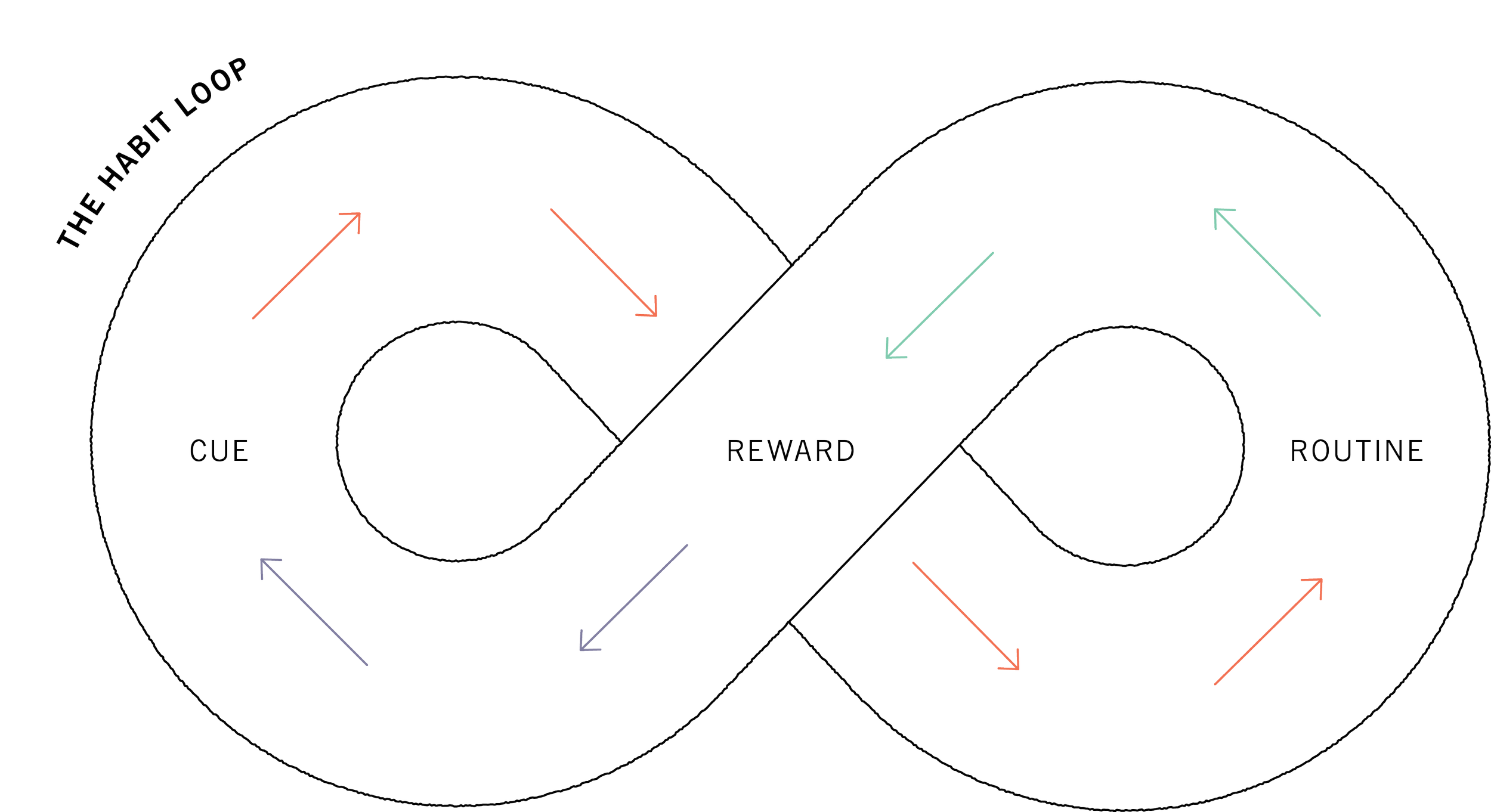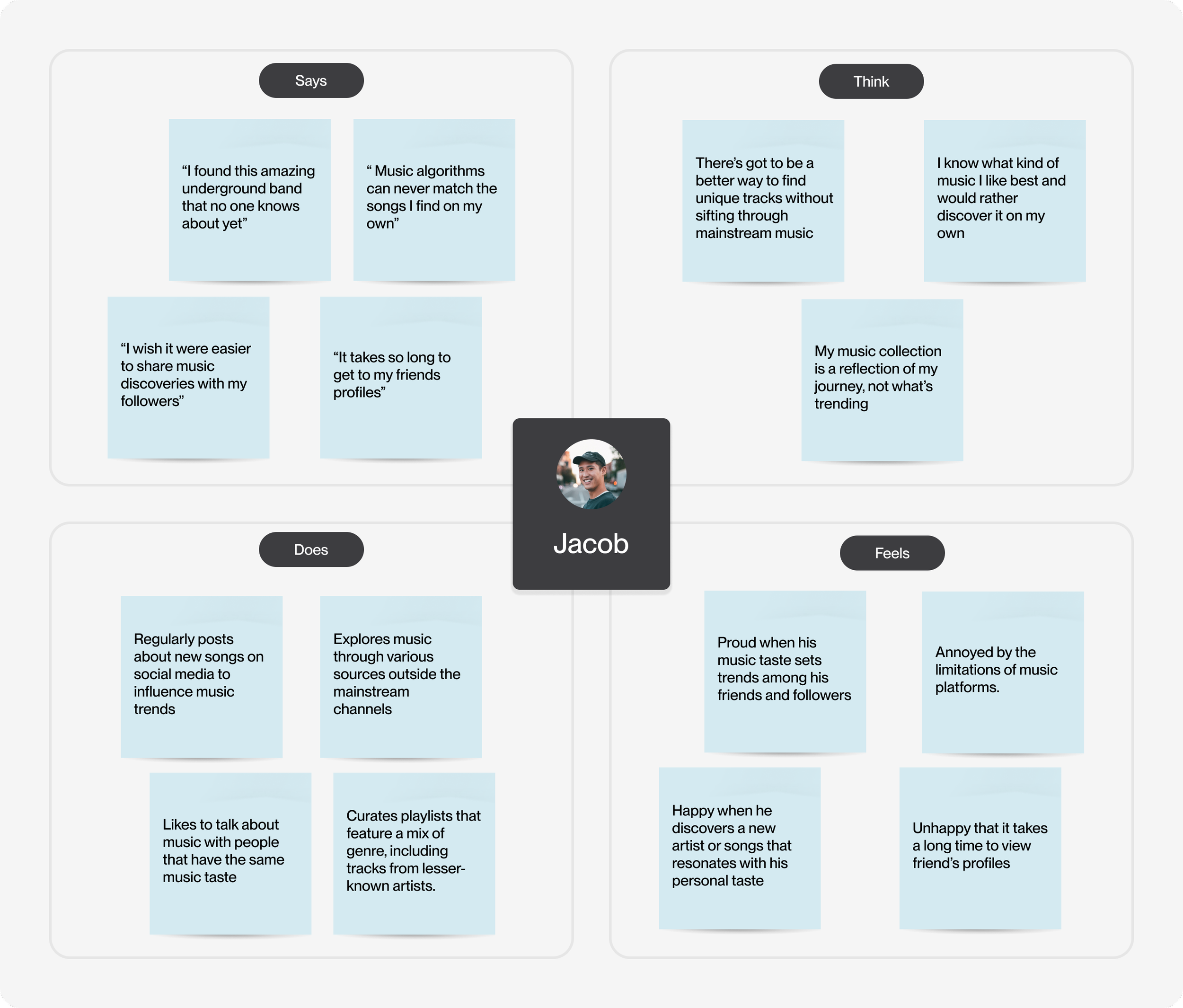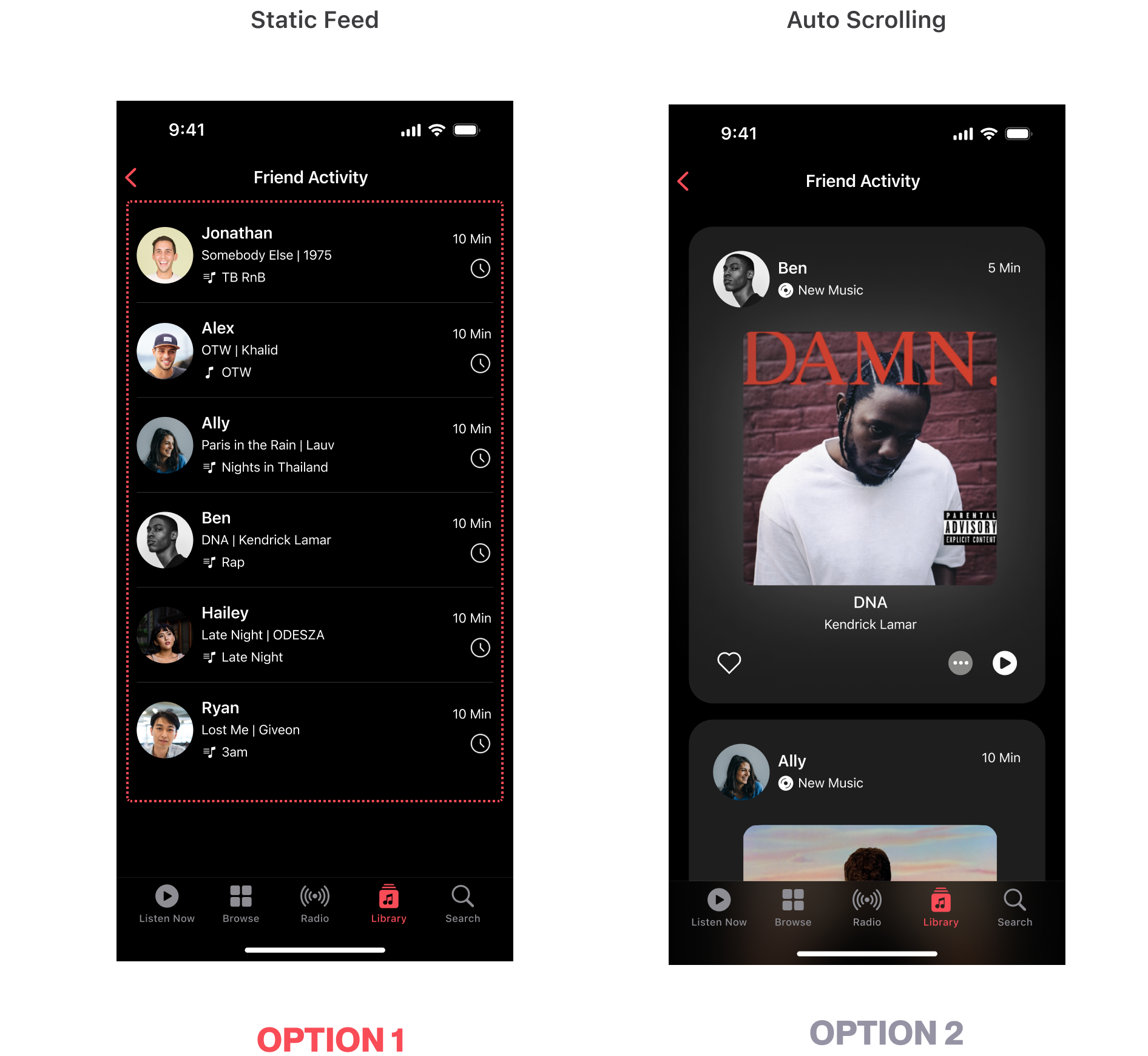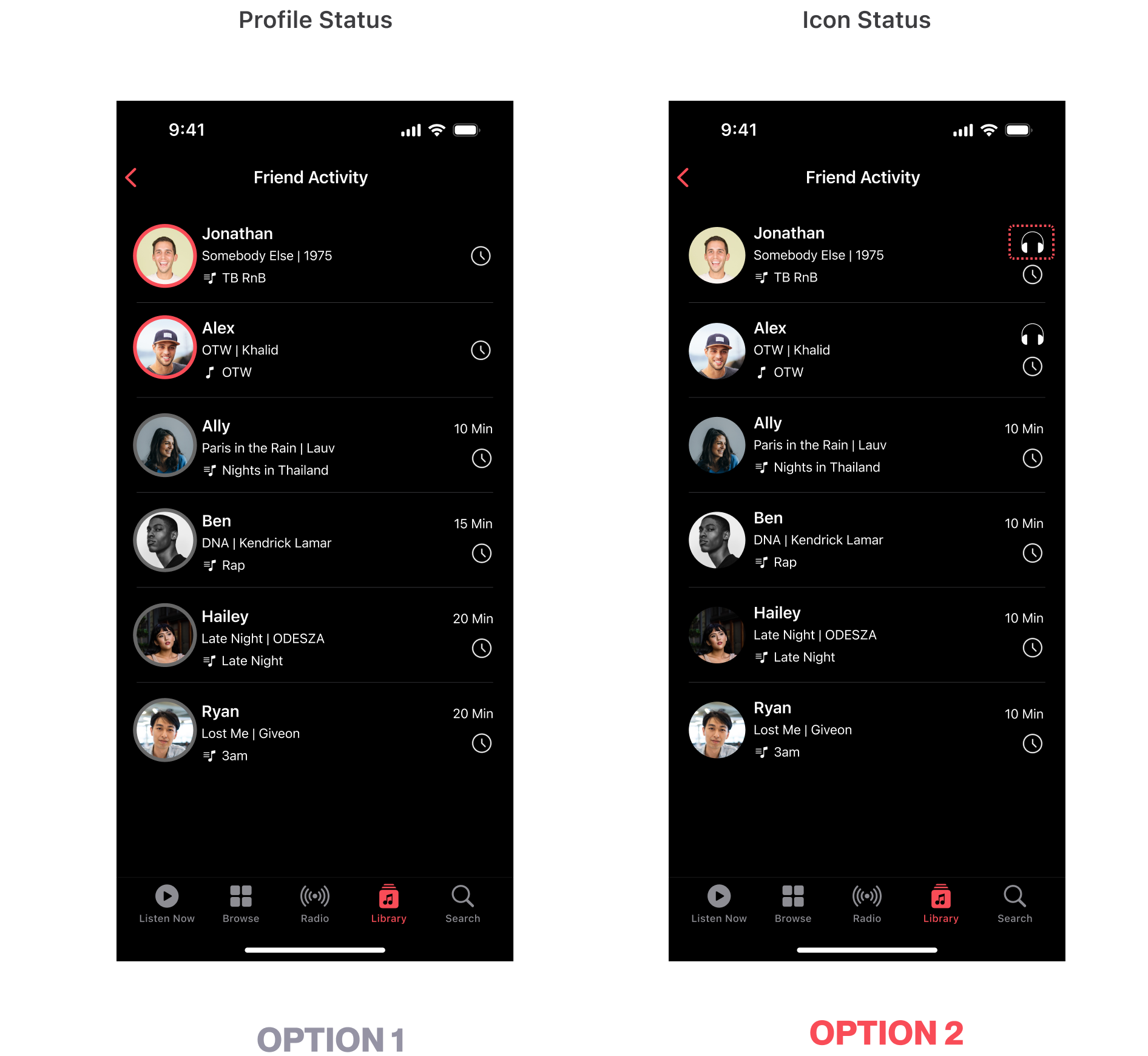Apple Music
See what your friends are listening to and share your current tracks on Apple Music.
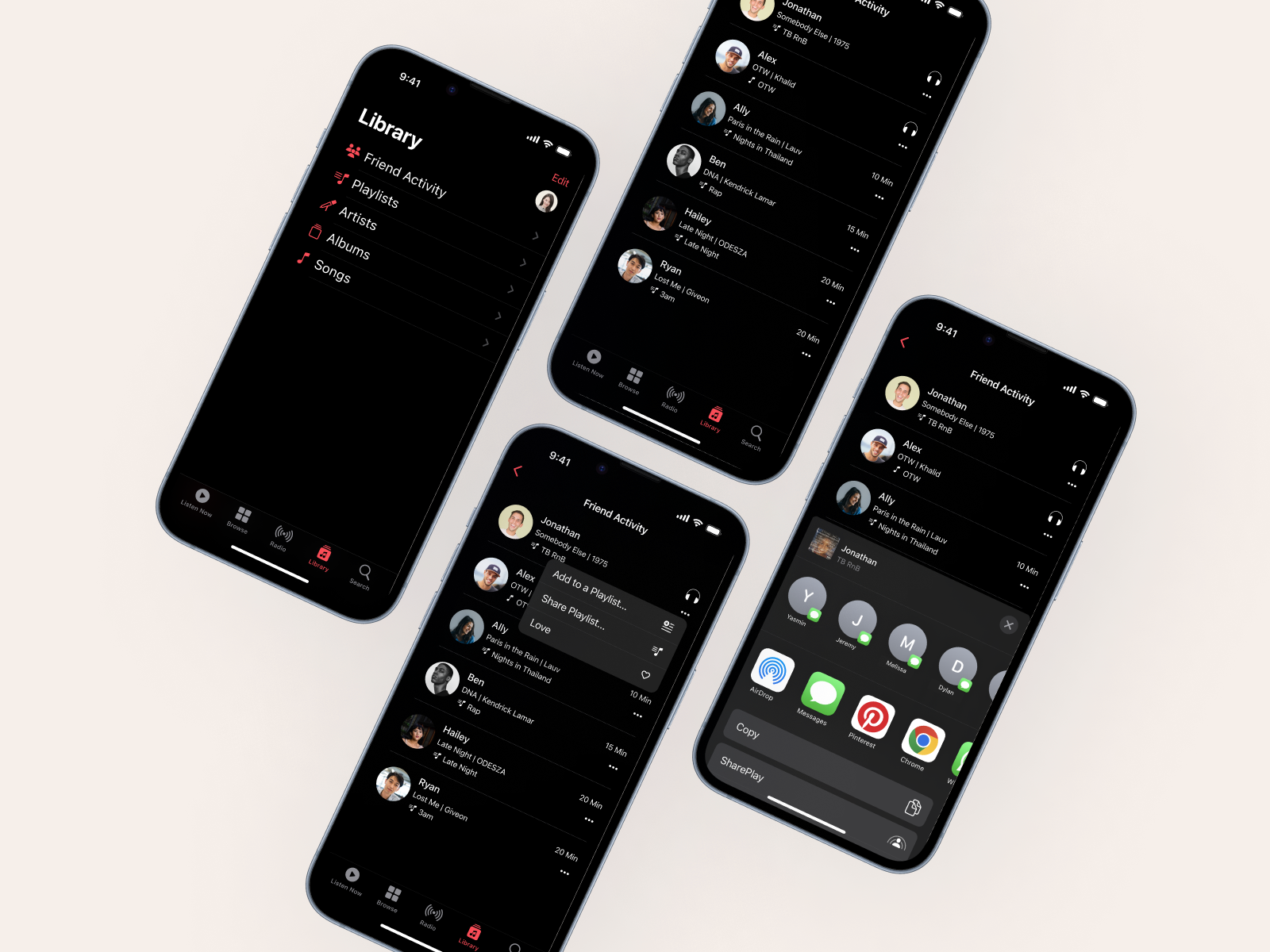
Role
Apple Music was a passion project, where I did research, testing, and prototyping.
Duration
One Month
Overview
Apple Music has revolutionized how people discover, listen to, and share music, setting new standards in the audio streaming industry. While Apple Music is renowned for its curated playlists and vast music library, what sets it apart is its seamless integration with social features. I contributed to designing a feature that allows users to easily access their friends' listening activities and share their own, enhancing social interaction and engagement within the app.
Team
Sole Product Designer
Tools
Figma and Sketch
Scope
UX/UI Design, User Research, and Usability Testing
The Problem
“ I can’t see my friend’s live listening activity on Apple Music.”
Due to my personal frustration with Apple Music's difficulty in seeing what friends were listening to, I wanted to explore how I could improve content discovery and engagement in the app. Many of my friends preferred Spotify, and I was curious why it was more popular. The current Apple Music app lets users see which playlists their friends are listening to, but it lacks the ability to show friends' live listening activity. Additionally, the process to view each friend's social feed is time-consuming.
Market Research
I love Apple Music, but why is it not the top streaming app?
According to Research , it suggests that Spotify leads, but there's room for growth in services like Apple Music through the addition of more social features. With this in mind, I see an opportunity for improvements to Apple Music that could increase its attractiveness and user base.
From analyzing competitors in the streaming industry, I discovered Apple Music's limited social features. Only Spotify shows friends' live activity, while YouTube Music and TIDAL lack social interaction. This analysis clarified the underlying issue and helped me to consider adding features for real-time sharing and discovery. By adding these features, it could satisfy the social needs of listeners.
Share of music streaming subscribers worldwide in the 3rd quarter of 2023, by company
With this in mind, it became clear that, unlike Spotify, Apple Music's absence of friends' activity features shows that there is a lack of user engagement and community building, elements that are key for a platform aiming to create a more interactive music experience.
The Goal
To boost social engagement within the app by implementing a Friend Activity feed
How Might We Statements
How might we enhance the Friend Activity feed to boost user engagement and increase app usage time?
How might we ensure the Friend Activity feature offers a seamless user experience?
How might we make users more enthusiastic about exploring playlist recommendations from their friends?
Research
On approaching the challenge of enhancing user engagement with Apple Music, it was crucial to understand how users discover and consume music, focusing on the psychological aspects that drive engagement and satisfaction.
Apple Music leverages the Self-Determination Theory (SDT) to fulfill the basic psychological needs of its users, which are Autonomy, Competence, and Relatedness.
Autonomy is the sense of control and freedom users have while using the app. Apple Music provides personalized playlists and the ability to create custom playlists, enhancing the user’s sense of autonomy.
Autonomy ➞ I can create personalized playlists.
Competence relates to users' need to feel effective in their interactions. Apple Music meets this need by offering curated playlists, tailored recommendations, and analytics that show users their listening habits and most-played songs, giving them a sense of accomplishment.
Competence ➞ I gain a sense of accomplishment through discovering new music and seeing my listening stats.
Relatedness addresses the desire to connect with others. Social features in Apple Music, such as sharing playlists and seeing what friends are listening to, fulfill this need by fostering a sense of community.
Relatedness ➞ Opens App and clicks on friends ’s profile to view which playlist they are listening to
The Habit Loop, as described in "The Power of Habit" by Charles Duhigg, consists of three components: Cue, Routine, and Reward. Apple Music effectively uses this model to form habits among its users.
Cue ➞ Receiving a notification about a friend's new playlist.
Routine ➞ Opens Apple Music and checks out the playlist.
Routine ➞ I enjoy new music and feels a sense of connection with the friend.
By consistently providing cues, encouraging routines, and delivering rewards, Apple Music effectively forms habits that keep users engaged with the app regularly. This model highlights how the app creates a cycle of engagement, reinforcing the behavior of exploring and enjoying music.
I conducted interviews with individuals who had experience using Apple Music. My goals were to :
Explore how users discover new music and artists on Apple Music.
Understand user engagement with social features, such as sharing playlists and viewing friends' listening activities.
Empathy Mapping
Every user encounters unique challenges and frustrations. Through empathy mapping, I was able to identify these specific pain points, ensuring that the solution I am developing is relevant and directly addresses the issues faced by different users.
User Research Findings
Through the interviews I conducted with Apple users, I was able to see patterns in how they discovered music and what their pain points were when using the app.
User-Driven Music Discovery
Users prefer discovering music independently.
They are interested in seeing what friends are listening to for reasons other than music discovery.
Music Sharing and Recommendations
Users rarely recommend music but do share to initiate conversations with those who have similar tastes.
Music Listening Habits
Music is often background noise during activities but becomes a conscious activity in specific situations like commuting and relaxing.
Lengthy Process:
Currently, users must navigate through multiple screens to view their friends' curated playlists. This process is time-consuming and detracts from the seamless experience users expect.
Hidden Features:
The option to view friends' playlists is not prominently displayed. Users often have to search through menus and profiles, making it a less intuitive experience.
Conducting User Interviews
While researching, I found unique music preferences shaping social interactions. Created 2 personas revealing varied music engagement paths. Identified issue with Apple Music lacking a social feed for users interested in connecting. Social Listener and Music Explorer personas emphasized need for social features, influencing design decisions.
SOCIAL LISTENER
Sandra
MUSIC EXPLORER
Robert
Exploring Iterations
I began refining the wireframe design with initial usability testing. Users gave feedback on the prototype's accessibility, readability, and ease of discovering features.
Implementing the “friend Activity” feature
How to use this feature to improve the process of music discovery
How to encourage users to share music
Initial wireframes and feedback
A seemingly simple component revealed multiple issues, significantly impacting the user experience. Below, I outline insights and design decisions to aimed at enhancing usability.Starting with sketches and wireframes, I refined my designs through prototyping and user testing with three participants. Feedback highlighted the need for a "Friend Activity" feature on the Library page, a hub of frequent musical engagement.
To enhance user convenience and ensure a smooth experience, I positioned "Friend Activity" prominently at the top of the Library page. This placement simplified the user's ability to discover what their friends are listening to, integrating social interactions seamlessly into their regular music browsing habits.
friendship in motion
Scroll Less, See More
My Users picked Option 1 and heres why I agree with them :
The Auto Scrolling option lacked the information users needed to quickly assess their friend's activity.
Static Feed offers a fast and direct glimpse into friends' music preferences, saving users time.
STATUS SPOLIGHT
active or inactive
My users picked Option 1 and here's why I disagree with them :
Several users I tested this screen with preferred option A because they could easily identify each user's status through the color-coded outlines.
However, upon reflection, I recognized that color-coded outlines might not be accessible to users with color vision deficiencies. To address this, I introduced a live listening icon in option 2 to differentiate between active and inactive states, enhancing accessibility.
INCREASE MUSIC LISTENINg
Boosting Music Via Sharing
My users picked Option 2 and here's why I agree with them :
User feedback reveals confusion regarding the clock icon, which was meant to indicate to "listen later".
I introduced a distinct share icon beside the headphones for straightforward song and playlist sharing, substituting the unclear clock icon to enhance user comprehension and engagement.
Measuring Success & Effectiveness
Here is how I would measure KPI's in this project if it were implemented:
Song Plays from Friend Activity: Count how many times users play songs they find on the friend activity screen.
Interactions with Friend Activity: Count clicks on profiles, new follows, and song shares from the friend activity feed.
Retention Rates: Compare how long users who use the friend activity stay on the app versus those who don't.
Usage of Friend Activity: Track how many users check out the friend activity screen at least once in a certain timeframe.
Retrospective
1. Focusing on the Entry Point
Focusing on the entry point was crucial in developing the friend activity feature. It's the user's first interaction, setting the tone for their experience. By optimizing this entry point, I ensured users found it easy and inviting to engage with the feature right from the start.
2. Reflecting on User Selection
In the project, I learned that choosing specific individuals for feedback could potentially mislead me. This realization highlighted the fact that the users I interviewed might not represent the wider population accurately, indicating that their perspectives may not fully capture the broader population's views.
3. Designing for two personas
A major lesson is learning how to balance the often competing needs and preferences of two distinct personas. Working with two personas made me think about prioritizing features and design elements based on their impact and relevance to each persona.



